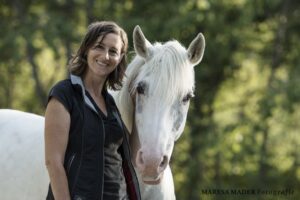Hallo,
ich bin’s, Michaela.
Wie schön, dass du hier gelandet bist.
Hast du bereits Clickertraining ausprobiert?
Noch nicht? Dann solltest du es unbedingt versuchen.
Oder vielleicht hast du gerade damit begonnen, bist begeistert (wer ist das nicht) und bist nun auf der Suche nach mehr Informationen?
Großartig!
Ich hoffe ich kann einige deiner Fragen beantworten.
Genau wie du begann ich mit einer Internetrecherche und landete dabei auf Alexandra Kurlands Webseite. Falls du ihren Blog noch nicht gefunden hast, dann solltest du hier eine Pause einladen ein paar ihrer hervorragenden Artikel lesen.
Ich warte auf dich…
Willkommen zurück!
Eine echte Schatztruhe, nicht wahr?
Ich begann ihre Artikel und Bücher zu lesen und ihre DVDs anzusehen.
Seit 2013 bin ich eine von Alexandra Kurlands coaches für den Online Kurs, den ich auf Deutsch übersetzt und im Jahr 2016 veröffentlicht habe.
Ich organisiere regelmäßig Workshops mit Alexandra in Deutschland und Italien und kombiniere diese mit der Teilnahme an Anja Berans International Classical Dressage Workshop.
Im Sommer 2019 habe ich das erste Clicker Training and Behaviour Science Summer Camp mit Alexandra Kurland, Jesús Rosales-Ruiz, und Mary Hunter organisiert und seit 2020 präsentiere ich dort ebenfalls regelmäßig.
Für 2021 hat mich Alexandra eingeladen mit ihr gemeinsam die
‚Stay-At-Home Clinics Series 2′ zu unterrichten und im Jannuar 2022 bei der ClickeExpo LIVE gemeinsam mit ihr zu präsentieren.
Meine Arbeit mit den Pferden basiert auf vier Grundpfeilern:
- Clickertraining
- Klassische Dressur
- Feldenkrais Methode
- Wissenschaft
Falls du lieber hörst als liest, dann möchte ich dir diese Podcast Epidoden vorschlagen, zu denen ich eingeladen war: Equiosity (u.a. Episoden 21, 22, 27, 28, 83), Horses for Future (Episoden 6,7), Friends on Horses, Knackfrosch & Gummistiefel and Pferdegewieher (Episoden 88, 108).





Mein Ziel
Mein Ziel ist es anderen Menschen zu helfen eine traumhafte BEZIEHUNG mit ihren Pferden aufzubauen, die auf Freudlichkeit basiert und sowohl die emotionale als auch physische BALANCE berücksichtigt.
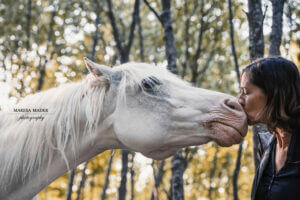
Um dies zu erreichen verwende ich Clickertraining, aufbauend auf einer Ethik welche sowol das Pferd als auch die Person respektiert.
Mich inspiriert eine wissenschaftliche Neugier sowohl theoretische als auch praktische Fragen zu erforschen.
Mit einer ähnlichen Neugier, Geduld und ohne Voreingenommenheit suche ich nach Balance, Eleganz, und Effizienz in der Bewegung bei Pferd und Mensch.
Meine Mentor:innen
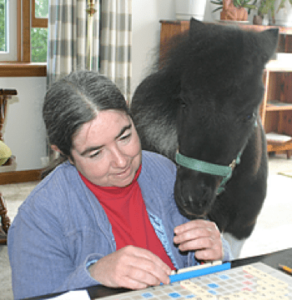
Ich habe CLICKERTRAINING von Alexandra Kurland gelernt. Als ich 2010 die ersten Versuche unternahm, haben mich die positiven Effekte auf mein Pferd und unsere Beziehung sehr schnell vom Clickertraining überzeugt und ich begann sehr intensiv das Material von Alexandra zu studieren und ihre Workshops zu besuchen.

Anja Beran bewundere ich ungemein als Reiterin und Ausbilderin, genau wie ihre Größzügigkeit und die Passion mit der sie sich für das Wohlergehen der Pferde einsetzt. Es war aber vor allem ihre Fähigkeit Pferde durch Reiten zu therapieren, die mich dazu bewegt hat von ihr mehr über die KLASSISCHE DRESSUR zu lernen. Selbst als ich mir nicht vorstellen konnte jemals selbst Lektionen wie Piaffe reiten zu können.

Jesús Rosales-Ruiz, Professor der Angewandten Verhaltensanalyse an der University of North Texas, der auch meine Masterarbeit betreut hat, und Mary Hunter, Verhaltensanalytikerin, Tiertrainerin und eine wahre Expertin darin komplexe wissenschaftliche Prinzipien verständlich zu erklären. Mehr über ihre Arbeit findet ihr hier.

Nathalie Van Cauwenberghe ist meine Lehrerin in der FELDENKRAIS-METHODE. Sie hat einen Hintergrund in klassischem Tanz und rhythmischer Gymnastik auf olympischem Niveau und eine Leidenschaft für anmutige Bewegungen im Gleichgewicht. Sie hat mir sehr geholfen, mein Körpergefühl zu verbessern und meine Kommunikation mit meinen Pferden effizienter und flüssiger zu gestalten.
Nun, da du meine Mentoren kennengelernt hast, möchte ich dir genauer beschreiben, wie jeder von ihnen meine Arbeit mit den Pferden beeinflusst.
Aber zuerst möchte ich dir Asfaloth vorstellen.
Asfaloth – meine eigene schöne Herausforderung
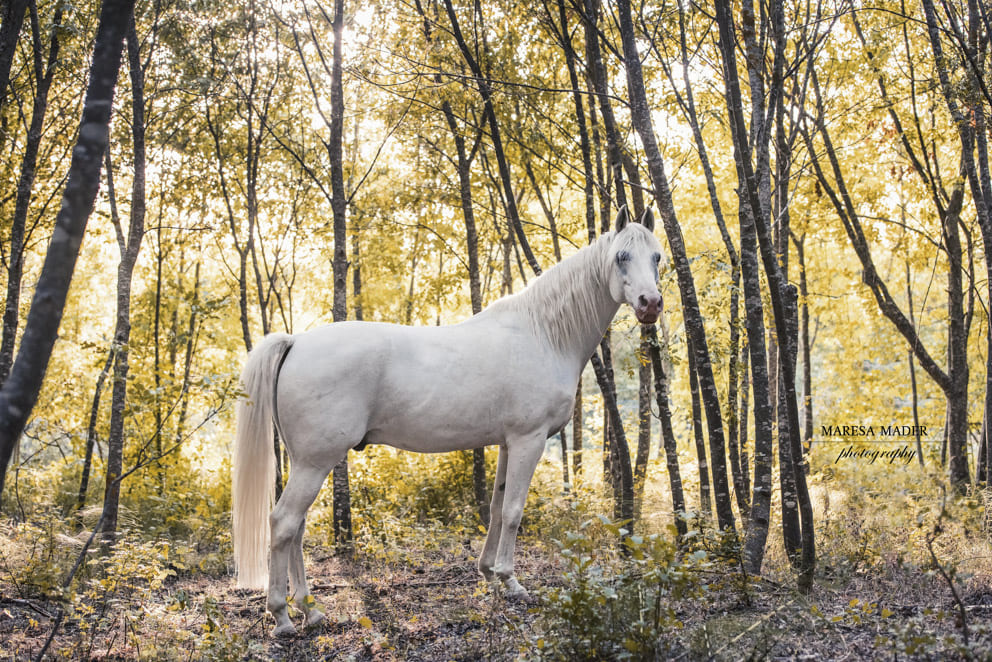
Asfaloth kam im Januar 2009 zu mir. Ein 10-jähriger Araber-Mix-Wallach, der als Reiningpferd ausgebildet wurde. Er war schön, aufmerksam, aber auch sehr verärgert.
Er hielt nicht still, wenn man ihn anband und drohte zu beißen, wenn man nach seinem Halfter griff oder ihn satteln wollte.
Reiten war nicht einfach. Er flüchtete sich oft in unkontrolliertes Rückwärtsgehen, manchmal auch ins Steigen, und war ein Experte darin, sich durch eine plötzliche Drehung vom Reiter zu befreien. Das war alles beherrschbar, aber nicht besonders lustig.
Wie konnte ich das ändern?
Durch Clickertraining
DRESSUR war schon immer meine Leidenschaft. Ich liebe die Harmonie zwischen Pferd und Reiter, diese magische Verbindung, die eine für Außenstehende unsichtbare Kommunikation schafft. Aber ich wusste nicht, wie ich das erreichen kann.
Also nahm ich Unterricht bei einer Ausbilderin für klassische Dressur in meiner Nähe.
Dann, während einer Unterrichtsstunde an einem kalten Winterabend, geschah etwas, das meine ganze Einstellung zum Pferdetraining und zum Leben im Allgemeinen veränderte.
Es war einer dieser kalten Tage, an denen der Schnee vom Dach rutscht und sich Pferde in tickende Zeitbomben verwandelt, die jeden Moment explodieren können.
Asfaloth war an diesem Abend explosiv und meine Trainerin sagte mir, ich solle ihn in schneller traben lassen, in der Hoffnung, er würde sich mehr auf die Arbeit konzentrieren. Das war eine dumme Idee (wie sich später herausstellte). Er war überfordert und begann zu buckeln. Beim dritten Buckeln hängte ich mich an seinen Hals. Er war brav und blieb stehen, aber ich kam nicht mehr in den Sattel, musste loslassen und fiel mit der Schulter zuerst auf den gefrorenen Boden.
Das Ergebnis war ein gebrochenes Schulterblatt und ich konnte einen Monat lang nicht reiten.
Im Nachhinein war das gut so, denn ich begann das umzusetzen, was ich in Alexandras THE-CLICK-THAT-TEACHES-Serie gelernt hatte.
Von der ersten Stunde an war ich erstaunt, wie schlau mein Pferd war (natürlich!) und wie viel Spaß wir hatten. Ich war süchtig.
Auch andere bemerkten die Veränderungen. Die Stallbesitzerin erzählte mir, wie verspielt Asfaloth geworden war und mein Tierarzt bemerkte, dass er viel freundlicher und kooperativer geworden war.
Klassische Dressur
Ich habe meine Dressurambitionen für eine Weile auf Eis gelegt, um mich auf das Clickertraining zu konzentrieren.
Aber ich hielt an meinem Ziel fest, die Harmonie zu erreichen, die ich bei den großen Reitern so bewundere. Im Jahr 2011 entdeckte ich meinen Weg zu diesem Ziel, als ich Anja Beran bei ihrem ersten jährlichen internationalen Workshop traf.
Was mich damals inspirierte, war ihre Fähigkeit, Dressur als Therapie einzusetzen. Sie stellte uns eine Reihe von Pferden vor, die bestenfalls als Weidegänger gedacht waren. Aber diese Pferde zeigten uns hervorragende Piaffen, fliegende Wechsel und vieles mehr.
Anja erklärte uns, wie sie diese Verwandlung erreicht, indem sie die Prinzipien der klassischen Dressur mit viel Geduld, Liebe und Geschick anwendet. In diesem Moment wusste ich, dass ich so viel wie möglich von Anja lernen wollte.
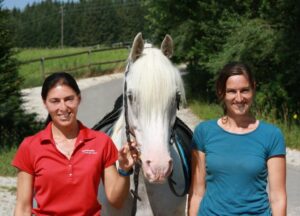
2012 habe ich mir ein Herz gefasst und bin mit Asfaloth über die Alpen gereist, um einen Monat mit Anja zu verbringen. Was ich in dieser Zeit gelernt habe, bestimmt bis heute das Training von Asfaloth (und den anderen Pferden).
Anja gab mir die Leitsätze, die ihm helfen, seinen Körper in ein besseres Gleichgewicht zu bringen. Meine Aufgabe war es, einen Weg zu finden, ihn zu unterrichten.
Das ist die Verbindung zum CLICKER TRAINING.
A im Quadrat
Aber WIE passen diese Puzzleteile zusammen?
Zunächst waren die Verbindungen zwischen der klassischen Dressur und Alexandras Clickertraining nicht offensichtlich. Alexandra hat aus gutem Grund keine Lektion mit dem Namen „Schulterherein“. Aber BALANCE ist in ihre Arbeit eingebettet und führt direkt zu den Lektionen, die wir aus der klassischen Dressur kennen.
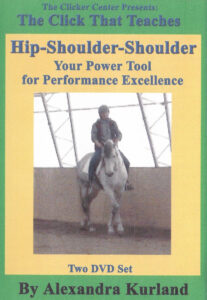
Die Verbindung wurde mir klar, als ich an einer Lektion namens „Hip-Shoulder-Shoulder“ (DVD Lektion 17 aus der Serie „The Click That Teaches“) arbeitete. Es war die Offenbarung, dass die Verbindung mit dem äußeren Zügel zum Kontakt führt, die für mich endlich einen Sinn ergab und die Arbeit von Alexandra Kurland mit dem verband, was ich von Anja Beran gelernt hatte.
[Anmerkung: Glaub nicht, dass du die Lektionen 1-16 einfach überspringen kannst, um den gleichen Effekt zu erzielen! Du brauchst die vorbereitenden Schritte!]
Von diesem Moment an sah ich überall VERBINDUNGEN.
Das nenne ich „A im Quadrat“:
Anja lehrt mich, WAS ich trainieren muss und Alex lehrt mich, WIE ich es trainieren muss.
Anjas Pferde bewegen sich so elegant und anmutig. Leicht wie eine Feder. Es ist eine Freude, ihr zuzusehen. Wer sie noch nicht reiten gesehen hat, sollte ihre Website besuchen und ihrer Facebook-Fanseite folgen. Sie hat auch tolle Bücher und DVDs.
Du solltest dir auch die Episoden 74, 75 und 76 von Equiosity anhören (Englisch), in denen Alexandra, ich und eine wunderbare Gruppe von Clicker-Trainern Anja zu einem privaten Gespräch getroffen haben.
Alexandras Basislektionen führen zu einer verbesserten Balance und Bewegung, die dem Pferd zugute kommt und sich in den fortgeschrittenen Lektionen weiter entwickelt. Alles ist miteinander verbunden.
Alexandra lehrt auch uns Reiter, uns in einer besseren Balance zu bewegen. Unsere Pferde sagen uns, wie wichtig das ist.
Und hier ist die Verbindung zur FELDENKRAIS-METHODE.
Feldenkrais Methode
Moshe Feldenkrais war eine außergewöhnliche Persönlichkeit. Lies seine Biografie, sie ist sehr interessant. Eine kurze Biographie findest du hier.
Die Methode, die er zunächst zur Behandlung seines verletzten Knies entwickelte, unterscheidet sich deutlich von Physiotherapie oder Körperübungen wie Pilates oder Yoga. Der FDV Feldenkrais Verband e.V. beschreibt die Methode sehr gut auf ihrer Webseite
Wenn du wissen möchtest, wie sich das auf das Training mit Pferden und insbesondere auf das Clickertraining auswirkt, dann höre dir die Episoden 144 und 145 des Equiosity-Podcasts mit der Feldenkrais-Praktikerin Anita Schnee an, die Alexandras Arbeit im Detail kennt und Alexandras Kurse leitet.
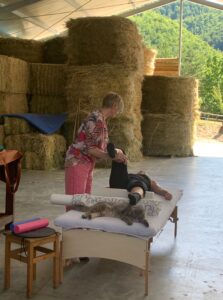
Ich nehme wöchentlich Feldenkrais-Stunden und meine Pferde sagen mir, dass es gut investierte Zeit ist.
Meine Kommunikation mit ihnen ist viel klarer und ich fühle mich insgesamt viel besser. Meine chronischen Rückenschmerzen sind verschwunden und mein Knie tut nicht mehr weh.
Und das wirkt sich auch auf mein Reiten aus.
Finde einen Therapeuten in deiner Nähe und probiere es aus.
Wissenschaft
Ich bin Wissenschaftlerin, und das macht mich per Definition zur Skeptikerin.
Bevor ich mich auf ein neues Projekt einlasse, recherchiere ich und schaue mir die Evidenz an.
Was mich am Clickertraining überzeugt hat, war die wissenschaftliche Basis.
Genauso zögerlich war ich übrigens bei der Feldenkrais-Methode, aber es gibt überzeugende Beweise für ihre Wirksamkeit. Also habe ich es ausprobiert.
Es stellte sich heraus, dass diese für mich neue Wissenschaft der Verhaltensanalyse ausgesprochen klich interessant ist. Es ist eigentlich näher an der Biologie (mein Fachgebiet als ausgebildete Tiermedizinerin) als an der Psychologie.
Ich begann, Lehrbücher und wissenschaftliche Artikel zu lesen. Eine sehr gute Einführung in dieses Gebiet ist der Kurs Living and Learning with Animals von Dr. Susan Friedman.
Ich wollte die Verhaltensanalyse in die Veterinärwissenschaften einführen.
Also überzeugte ich Jesús Rosales-Ruiz, meine Masterarbeit in Pferdewissenschaften über stereotypes Verhalten zu betreuen. Zu meiner Überraschung nahm die Universität Edinburgh meinen Vorschlag an.
Damit begann eine ganz neue Entdeckungsreise, die ich an anderer Stelle beschreiben werde.
Ich möchte nur sagen, dass mir diese Reise ein neues Verständnis von Verhalten und Training gebracht hat – und ein neues Pferd.
Aber davon später.
Für den Moment möchte ich dir all das mit auf den Weg geben.
Erforsche die Ressourcen, die ich dir zur Verfügung gestellt habe, und wenn du möchtest, komm auf diese Website zurück, um noch mehr zu erforschen.
Viel Spaß dabei.
Mit freundlichen Grüßen
Michaela
(Dr. med. vet. Michaela Hempen MSc)
